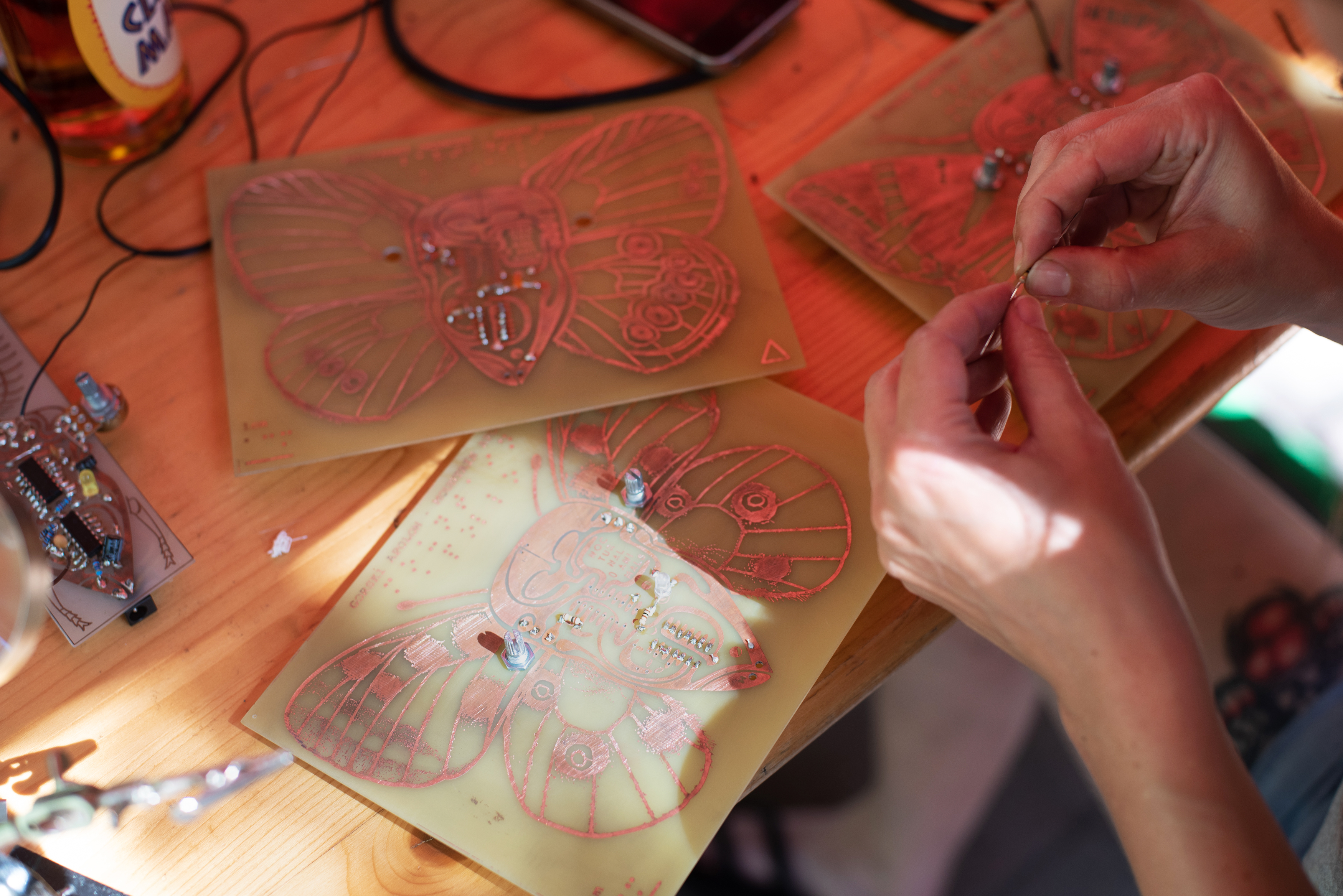Sounding the mountain butterflies. To sound is to seek to ascertain its depth, to emit audible tone, to learn about its position, to protect or to be save. Sound as fathoming, resounding, uttering, being heard, conveying impressions, suggesting analogies.
Analog electronic instruments for visually impaired. Electronic circuit of Noctural Animals, which is designed as a thorax of butterfly or moth, is based on the first electronic musical instrument called theremin. It was invented by a Russian physicist Leon Sergeyevich Theremin in 1920s. This is an unique instrument, because it can be played without touching it and only with changing the distance of users’ hands from two electrodes – antennas or sliding with fingers over the copper lines.
With a wish to spread awarness about rapid decline of insects (so called windshield phenomen – 2.5% rate of annual loss over the last 25-30 years, especially butterflies, moth and bees), this is an upgraded design version of MOTHeremin with electronic circuits replicating patterns of the most endagered lepidopterans in Slovenia. Etched circuits on copper plates form a relief, therefore analog electronic instrument are a learning sonic tool for the blind and visually impared. Sliding through the copper lines, patterns users will get to know the most endagered butterflies and moths of Slovenia not just through touch, but also through sound. Beside that users will be able to learn the basics of electricity flow and electronic components.
Three analog electronic instruments resembling endangered lepidopterans were designed during PIFcamp DITOxication which is a 7-day hacker-base set in Slovenian nature, where art, technology and knowledge meet.
Mountain Apollo (lat. Parnassius apollo), inhabitates hills, flowery alpine meadows, pastures of the continental European mountains of high altitudes from 400 up to 2,300 metres. This species requires specific climatic conditions like cold winter, sunny summer, wide open spaces and a large surface of lawns. The presence of the host plant for the caterpillars is critical. It has a wingspan of approximately eighty millimetres. The female is a larger than the male. The Apollo butterfly shows a great deal of individual variation in the appearance, it is mostly white and decorated with five large black eyespots on the forewing and two bright red or orange eyespots on the hindwing. The wings are shiny, with slightly transparent edges, caterpillars of this species are velvety black with orange-red spots along the sides. Mountain Apollo is listed on IUCN Red List of Threatened Species. One of the probable causes of extinction is the warming of the climate. Apollo is an atypical glacial invader and that with the warming of the climate in mountainous regions is causing the butterfly to not readily adapt to such an uncomfortable environment.
False Ringlet (lat. Coenonympha oedippus) is one of the most threatened European butterfly species, and protected by the Habitats Directive and Bern Convention. In Slovenia the species and its habitats are protected by law. The species’ habitats on Ljubljana Marsh are alkaline fens and oligotrophic (non-fertilised) wet meadows. Adults fly in a single generation from beginning of June until mid July. The main nectar species for butterflies are Tormentil, Devil’s-bit Scabious and Lesser Spearwort. Females lay single eggs on different substrata: mainly on larval host-plants, but also on other plant species in their close vicinity. Larvae are heliophilous and thermophilous: they are feeding during the day and basking in the sun in the warmest part of the day in late autumn and early spring. Caterpillars partially feed on their food-plants until the onset of November and some keep sitting (basking) on upper parts of their food-plants even in winter. After hibernation the larvae are still quite small (about 1.3 cm) and not able to move very far to search for food. Thus, they have to find host-plants in their immediate vicinity within a few days as their need for food and liquid is urgent after the long period of starvation during hibernation. At that time, the winter-green leaves of Carex species are the most important food as the Molinia leaves grow to sufficient largeness only about two weeks (or even more) after larval awakening. The larvae pupate on stems or leaves in the middle layer of herb vegetation.
Jersey Tiger (lat. Euplagia quadripunctaria) is a day-flying moth of the family Erebidae. The adult wingspan is 52–65 millimetres, and they fly from July to September, depending on the location. They tend to fly close to Eupatorium cannabinum, where they are hard to notice because of their camouflag. The larvae (caterpillars) are polyphagous, feeding from September to May on nettles and raspberries, dandelion, white deadnettle, ground ivy, groundsel, plantain, borage, lettuce, and hemp-agrimony. The insect overwinters as a small larva.


